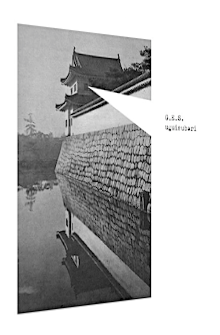
Gesellschaft Zur Emanzipation Des Samples
Uguisubari
2017
Uguisubari is a two-track seven-inch LP and digital download by multiversed Exotica/Ambient veteran Jan Jelinek. Once again deciding to resurrect his faux-society platform Gesellschaft Zur Emanzipation Des Samples, or G.E.S. in short, the Berlin-based audiovisualist takes analog concepts to varyingly polyfaceted and thus always exotic degrees.
Released in September 2017 on his own Faitiche label and distributed by Morr Music, the mere runtime of a bit over seven minutes makes Jelinek's latest offering a stupefyingly short interim appetizer, or so it seems by the first look of things. As it turns out later, this short runtime is less about nurturing that sort of fleeting exotic escapism and more about elucidating esoteric elevation of a highly specific phenomenon: the titular uguisabri, a nightingale floor conceptualized and refined during Japan's Edo period.
Uguisubari is not just about these aurally multifaceted floors; it is made of these floors which Jelinek experienced on site in Japan during a months-long visit in 2014. Installed and perfected to warn inhabitants from intruders by making squeaky, creaking noises that remind of chirping birds, it turns out — much to Jelinek's own surprise — that the floors' existence is almost forgotten now, both regarding contemporary history and by Hollywood's kaleidoscopic standard of attention; Ian Fleming's 007 James Bond spy series makes particular mention of the uguisubari warning system, and there's the occasional erudite YouTube video, but that almost seals the deal.
And now thanks to Jan Jelinek, these floors can thrive, aided only by an oscillator and a sound board. Uguisubari hence offers a purposefully reduced listening experience: unlike the bedazzlingly auroral travelog Circulations (2009), the guiro-and-string infused washes of More Circulations (2012) or the Exotica-infested — with ancillary Teutonicism — 2014 joint release Do You Know Otahiti? crafted by Masayoshi Fujita and Jelinek, here we have a pinpointed, precise and incisive collage of wooden floorboards, clamps and several kinds of metallics where sound, sustain and silence manifest themselves in microscopic forms and shapes, true to form when it comes to the characteristic trait of these nightingale floors: the harder you sneak, the louder they creak.
Nijo-Jo, recorded at Nijo Castle in Kyoto in 2014, throws the listener into a place that is both ligneous and pristine at the same time. Throwing is not the most beautiful of terms, but the short runtime of the seven inch release takes its toll. After a short organ riff (or a synthetic approximation thereof), Jelinek continues to harvest helicoidal tone sequences whose repetitive corkscrew attitude mobs among the floor. In lieu of a hazingly soft launch, Nijo-Jo's streamlet immediately turns into a faintly nomological kaleidoscope of orthogonal isospins, subatomic lo-freq blebs and razzling shakers. In the center of it all: not the titular floorboards in recognizable form, but rather a six-to-eight note coil that twirls into the orthonormal afterglow during the track's last third which, as it turns out, is as Ambient as can be in the given setup.
Nanzen-ji, a famous temple located in the Eastern hills of Kyoto, tastes, synesthetically spoken, amethystine. Far away from anything Detroit, shapeshifting apparitions related to the US megacity are to be found in this tune against all possible odds. The wooden parts are gnarling right from the get-go, a retinue of mauve-colored low poly globs oozes profound depths. Clicks and steps, electropositive as can be. Adaxial pulses echo into the cavernous distance which is filled with the sounds of splutters and chimes. Despite the minimalism, the sources are anything but monoclinic. In fact, it is the wealth of right sounding wood and the benthic-aquatic magnetotail of the oscillator that make Nanzen-ji a caustic cocoon of plasticity.
Uguisubari offers exactly what Jan Jelinek has been known for in recent years: pulsatile high-chroma metalicity by means of analog gluons, veneered veils and a cornucopia of punctilio. Putting this short a single into the Exotica section — even just for the sake of affirming the artists more paradisiac material mentioned in greater detail here at AmbientExotica — is both an audacity and endeavor. But since the Exotica section is also covering large portions of blip-infested 50's Space Age like Ferrante & Teicher's Soundproof (1955), Danny & Dena Guglielmi's Adventure In Sound (1956) or Russ Garcia's Fantastica (1958), the latter being stashed away as well in Jelinek's zoetropic treasure chest, Uguisubari suddenly feels like the rightful next of kin to this nexus.
It is small-ish by nature, doesn't overstay its welcome, ameliorates its wooden state by lanthanides as well as sound-based rotoscoping, and is the first step to a series of similarly themed short singles with an array of differing introspectives concerning the innermost soul of aural phenomena: Uguisubari chirps, twists and turns. Syllabic streams in lieu of poppy melodies, polished prestidigitation in favor of hummable helixes, incidental incision crushes accidental laissez-faire. Short but sweet, all floorboards on deck: lift up, Uguisubari!
Further listening and reading:
You can find more information on Jan Jelinek's Faitiche label and can also purchase the seven-inch version there. The download and streaming version meanwhile is available on Amazon MP3, iTunes and cohorts.
Exotica Review 487: Gesellschaft Zur Emanzipation Des Samples – Uguisubari (2017). Originally published on Sep. 9, 2017 at AmbientExotica.com.
